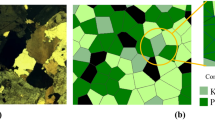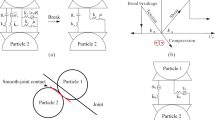Abstract
In this research paper, smoothed particle hydrodynamics (SPH) with Johnson Holmquist damage model is adopted for modelling of the blast-induced fractures in Barre granite rock. The permeability of the blast-induced rock is then obtained using the implemented finite volume method code in OpenFOAM. It is found that the calculated permeability depends on the direction of fluid flow and with higher value in radial direction than the axial one. This is mainly due to the higher and larger connected pore network in the radial direction. This research work shows that the adopted SPH method along with finite volume method code can be effectively combined to qualitatively and quantitatively predict the fractured network, to analyse geometry of the fractured network, and to calculate the permeability of blast-induced rock.











Similar content being viewed by others
References
Sarbhukan MM (1990) Application of bore-blast technique for rock fracturing for drinking water: a case study of Ghotkarwadi, Taluka Akole District Ahmednagar. In: Proceedings of national seminar on modern techniques of rain water harvesting, water conservation and artificial recharge for drinking water, afforestation, horticulture and agriculture, Government of Maharashtra (India)
Li W, Xue Z (2000) A review of gas fracturing technology. In: SPE, international petroleum conference and exhibition, Villahermosa, Mexico
Guo B, Shan J, Feng Y (2014) Productivity of blast-fractured wells in liquid-rich shale gas formations. J Nat Gas Sci Eng 18:360–367
Miller JS, Johansen RT (1976) Fracturing oil shale with explosives for in situ recovery. Bartlesville Energy Research Centre, Bartlesville, Okla. 74003. Advances in Chemistry. American Chemical Society, Washington, DC
Austin CF, Leonard GW (1973) Chemical explosive stimulation of geothermal wells. Geothermal energy resources, production and stimulation. Stanford University Press, Stanford, pp 269–292
Zhu WC, Wei CH, Li S, Wei J, Zhang MS (2013) Numerical modelling on destress blasting in coal seam for enhancing gas drainage. Int J Rock Mech Min Sci 59:179–190
Mokfi T, Shahnazar A, Bakhshayeshi I, Mahmodi Derakhsh A, Tabrizi O (2018) Proposing of a new soft computing based model to predict peak particle velocity induced by blasting. Eng Comput 34:881–888
Dehghan Banadaki MM (2010) Stress-wave induced fracture in rock due to explosive action. Ph.D. Dissertation, University of Toronto
Nasseri MHB, Rezanezhad F, Young RP (2011) Analysis of fracture damage zone in anisotropic granitic rock using 3D X-ray CT scanning techniques. Int J Fract 168:1–13
Alañón A, Cerro-Prada E, Vázquez-Gallo J, P.Santos M A (2018) Mesh size effect on finite element modelling of blast-loaded reinforced concrete slab. Eng Comput 34:649–658
Bendezu M, Romanel C, Roehl D (2017) Finite element analysis of blast induced fracture propagation in hard rocks. Comput Struct 182:1–13
Potyondy D, Cundall P, Sarracino R (1996) Modelling of shock- and gas-driven fractures induced by a blast using bonded assemblies of spherical particles. In: Mohanty B (ed) Rock fragmentation by blasting. A A Balkema, Rotterdam, pp 55–62
Pramanik R, Deb D (2015) Implementation of smoothed particle hydrodynamics for detonation of explosive with application to rock fragmentation. Rock Mech Rock Eng 16:92–99
An HM, Liu HY, Han H, Zheng X, Wang XG (2017) Hybrid finite-discrete element modelling of dynamic fracture and resultant fragment casting and muck-pilling by rock blast. Comput Geotech 81:322–345
Trivino LF, Mohanty B (2015) Assessment of crack initiation and propagation in rock from explosion-induced stress waves and gas expansion by cross-hole seismometry and FEM–DEM method. Int J Rock Mech Min Sci 77:287–299
Fakhimi A, Lanari M (2015) DEM–SPH simulation of rock blasting. Comput Geotech 55:158–164
Mishra BK, Murty CVR (2001) On the determination of contact parameters for realistic DEM simulations of ball mills. Powder Technol 115:290–297
Belytschko T, Lu YY, Gu L (1995) Element-free Galerkin methods for static and dynamic fracture. Int J Solids Struct 32:2547–2570
Wang D, Li Z, Li L, Wu Y (2011) Three dimensional efficient mesh free simulation of large deformation failure evolution in soil medium. Sci China Technol Sci 54:573–580
Vignjevic R, Campbell J (2009) Review of development of the smooth particle hydrodynamics (SPH) method. In: Hiermaier S (ed) Predictive modeling of dynamic processes. Springer, Boston, MA, pp 367–396
Dautriat J, Gland N, Guelard J, Dimanov AL, Raphanel J (2009) Axial and radial permeability evolutions of compressed sandstones: end effects and shear-band induced permeability anisotropy. Pure Appl Geophys 166:1037–1106
Heiland J (2003) Laboratory testing of coupled hydro-mechanical processes during rock deformation. Hydrogeol J 11:122–141
Fourar M, Radilla G, Lenormand R, Moyne C (2004) On the non-linear behaviour of a laminar single-phase flow through two and three-dimensional porous media. Adv Water Resour 27:669–677
Newman MS, Yin X (2013) Lattice Boltzmann simulation of non-Darcy flow in stochastically generated 2D porous media geometries. SPE J 18:12–26
Thauvin F, Mohanty K (1998) Network modelling of non-Darcy flow through porous media. Transp Porous Med 31:19–37
Soulaine C, Tchelepi HA (2016) Micro-continuum approach for pore-scale simulation of subsurface processes. Transp Porous Med 113:431–456
Javadi M, Sharifzadeh M, Shahriar K (2010) New geometrical model for non-linear fluid flow through rough fractures. J Hydrol 389:18–30
OpenFOAM (2015) User guide, version 2.0.0, OpenCFD Ltd, UK. http://www.openfoam.org. Accessed 3 June 2016
Guibert R, Nazarova M, Horgue P, Hamon G, Creux P, Debenest G (2015) Computational permeability determination from pore-scale imaging, sample size, mesh and method sensitivities. Transp Porous Med 107:641–656
Scanlon TJ, White CK, Borg MC, Palharini R (2015) Open-source direct simulation monte carlo chemistry modelling for hypersonic flows. AIAA J 53:1670–1680
Fabritius B, Tabor G (2016) Improving the quality of finite volume meshes through genetic optimisation. Eng Comput 32:425–440
Dong H, Blunt MJ (2009) Pore network extraction from micro computerized tomography images. Phys Rev E 80:1–11
Jung HB, Kabilan S, Carson JP, Kuprat AP, Um W, Martin PF, Dahl M, Kafentzis T, Varga T, Stephens S, Arey B, Carroll KC, Bonneville A, Fernandez CA (2014) Wellbore cement fracture evolution at the cement—basalt caprock interface during geologic carbon sequestration. Appl Geochem 47:1–16
Li L, Shen L, Nguyen GD, El-Zein A, Maggi F (2018) A smoothed particle hydrodynamics framework for modelling multiphase interactions at meso-scale. Comput Mech 62:1071–1085
Monaghan J (1992) Smoothed particle hydrodynamics. Annu Rev Astron Astrophys 30:543–574
LS-DYNA LSTC (2015) Keyword user’s manual, Version R9.0.1, Livermore Software Technology Corporation, Livermore
Gray JP, Monaghan JJ, Swift RP (2001) SPH elastic dynamics. Comput Methods Appl Mech Eng 190:6641–6662
Liu MB, Liu GR (2010) Smoothed particle hydrodynamics (SPH): an overview and recent developments. Arch Comput Methods Eng 17:25–76
Johnson GR, Holmquist TJ (1999) Response of boron carbide subjected to large strains, high strain rates, and high pressures. J Appl Phys 85:8060–8073
Ranjan R (2007) Dynamic compression measurements on selected granitic rocks using split Hopkinson pressure bar test. M.A.Sc. Dissertation, University of Toronto
Johnson GR, Cook WH (1985) Fracture characteristics of three metals subjected to various strains, strain rate, temperatures and pressures. Eng Fract Mech 21:31–48
Boisvert JB, Manchuk JG, Neufeld C, Niven EB, Deutsch CV (2012) Micro-modelling for enhanced small scale porosity–permeability relationships. In: Abrahamsen P, Hauge R, Kolbjornsen O (eds) Geostatistics. Springer, Dordrecht
Acknowledgements
The work was supported in part by the Australian Research Council through Discovery Projects (DP140100945 and DP170102886) and by the National Natural Science Foundation of China (Grant no. 11232003). This research was undertaken with the assistance of resources and services from the National Computational Infrastructure (NCI), which is supported by the Australian Government.
Author information
Authors and Affiliations
Corresponding author
Additional information
Publisher’s Note
Springer Nature remains neutral with regard to jurisdictional claims in published maps and institutional affiliations.
Rights and permissions
About this article
Cite this article
Gharehdash, S., Shen, L. & Gan, Y. Numerical study on mechanical and hydraulic behaviour of blast-induced fractured rock. Engineering with Computers 36, 915–929 (2020). https://doi.org/10.1007/s00366-019-00740-1
Received:
Accepted:
Published:
Issue Date:
DOI: https://doi.org/10.1007/s00366-019-00740-1




